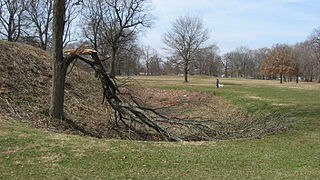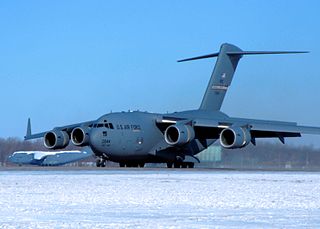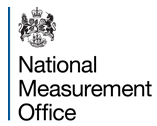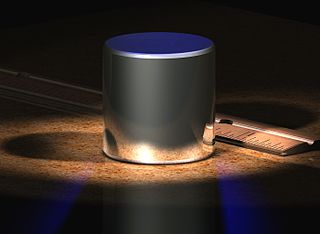Related Research Articles
The National Institute of Standards and Technology (NIST) is an agency of the United States Department of Commerce whose mission is to promote American innovation and industrial competitiveness. NIST's activities are organized into physical science laboratory programs that include nanoscale science and technology, engineering, information technology, neutron research, material measurement, and physical measurement. From 1901 to 1988, the agency was named the National Bureau of Standards.
In measurement technology and metrology, calibration is the comparison of measurement values delivered by a device under test with those of a calibration standard of known accuracy. Such a standard could be another measurement device of known accuracy, a device generating the quantity to be measured such as a voltage, a sound tone, or a physical artifact, such as a meter ruler.

Metrology is the scientific study of measurement. It establishes a common understanding of units, crucial in linking human activities. Modern metrology has its roots in the French Revolution's political motivation to standardise units in France when a length standard taken from a natural source was proposed. This led to the creation of the decimal-based metric system in 1795, establishing a set of standards for other types of measurements. Several other countries adopted the metric system between 1795 and 1875; to ensure conformity between the countries, the Bureau International des Poids et Mesures (BIPM) was established by the Metre Convention. This has evolved into the International System of Units (SI) as a result of a resolution at the 11th General Conference on Weights and Measures (CGPM) in 1960.

Heath is a city in Licking County, Ohio, United States, and is located approximately 30 mi (48 km) east of Columbus. The population was 10,412 at the 2020 census.

Wright-Patterson Air Force Base (WPAFB) is a United States Air Force base and census-designated place just east of Dayton, Ohio, in Greene and Montgomery counties. It includes both Wright and Patterson Fields, which were originally Wilbur Wright Field and Fairfield Aviation General Supply Depot. Patterson Field is approximately 16 kilometres (10 mi) northeast of Dayton; Wright Field is approximately 8.0 kilometres (5 mi) northeast of Dayton.

A Kibble balance is an electromechanical measuring instrument that measures the weight of a test object very precisely by the electric current and voltage needed to produce a compensating force. It is a metrological instrument that can realize the definition of the kilogram unit of mass based on fundamental constants.

The Air Force Research Laboratory (AFRL) is a scientific research and development detachment of the United States Air Force Materiel Command dedicated to leading the discovery, development, and integration of direct-energy based aerospace warfighting technologies, planning and executing the Air Force science and technology program, and providing warfighting capabilities to United States air, space, and cyberspace forces. It controls the entire Air Force science and technology research budget which was $2.4 billion in 2006.

MacDill Air Force Base is an active United States Air Force installation located 4 miles (6.4 km) south-southwest of downtown Tampa, Florida.

Rome Laboratory is the US "Air Force 'superlab' for command, control, and communications" research and development and is responsible for planning and executing the USAF science and technology program.
Base Realignment and Closure (BRAC) was a process by a United States federal government commission to increase the efficiency of the United States Department of Defense by coordinating the realignment and closure of military installations following the end of the Cold War. Over 350 installations were been closed in five BRAC rounds: 1988, 1991, 1993, 1995, and 2005. These five BRAC rounds constitute a combined savings of $12 billion annually.

The Air Force Materiel Command (AFMC) is a Major Command (MAJCOM) of the United States Air Force (USAF). AFMC was created on July 1, 1992, through the amalgamation of the former Air Force Logistics Command (AFLC) and the former Air Force Systems Command (AFSC).

McClellan Air Force Base (1935–2001) is a former United States Air Force base located in the North Highlands area of Sacramento County, 7 miles (11 km) northeast of Sacramento, California.

Brooks Air Force Base was a United States Air Force facility located in San Antonio, Texas, 7 miles (11 km) southeast of Downtown San Antonio.
ISO/IEC 17025General requirements for the competence of testing and calibration laboratories is the main standard used by testing and calibration laboratories. In most countries, ISO/IEC 17025 is the standard for which most labs must hold accreditation in order to be deemed technically competent. In many cases, suppliers and regulatory authorities will not accept test or calibration results from a lab that is not accredited. Originally known as ISO/IEC Guide 25, ISO/IEC 17025 was initially issued by ISO/IEC in 1999. There are many commonalities with the ISO 9000 standard, but ISO/IEC 17025 is more specific in requirements for competence and applies directly to those organizations that produce testing and calibration results and is based on more technical principles. Laboratories use ISO/IEC 17025 to implement a quality system aimed at improving their ability to consistently produce valid results. Material in the standard also forms the basis for accreditation from an accreditation body.
A Precision Measurement Equipment Laboratory (PMEL) is a United States Air Force (USAF) facility in which the calibration and repair of test equipment takes place. This practice is also known as metrology: the science of measurement. Metrology is defined as the science of weights & measures, while a PMEL is the place where technicians perform all of the metrology for the U.S. Air Force. Air personnel in this career field are primarily responsible for the repair, calibration, and modification of test, measurement, and diagnostic equipment (TMDE), including precision measurement equipment laboratory standards and automatic test equipment. They also supervise the process and use of TMDE to perform voltage, current, power, impedance, frequency, microwave, temperature, physical-dimensional, and optical measurements. They perform these functions in a strictly controlled laboratory environment where the temperature and humidity are constantly monitored. The Air Force Specialty Code (AFSC) of air personnel trained to work in the PMEL is 2P0X1 replacing 324X0 where "X" represents a variable number which denotes the level of expertise of the individual. There are also defense contractors and government civilians who perform this job. The Air Force's PMELs are governed by AFMETCAL

The National Measurement and Regulation Office (NMRO) was an executive agency of the UK Government's Department for Business, Innovation and Skills (BIS). Its function were to provide a measurement infrastructure which supports innovation, facilitates fair competition, promotes international trade and protects consumers and the environment.
The Advanced Technical Intelligence Center for Human Capital Development (ATIC) is a university and industry-focused research, education, and training nonprofit corporation within the Dayton Region.It consolidates technical intelligence education and training in the DoD, national agencies, and civilian institutes and industry.

NCSL International (NCSLI) is a global, non-profit organization whose membership is open to any organization with an interest in metrology and its application in research, development, education, and commerce.

In metrology, a standard is an object, system, or experiment that bears a defined relationship to a unit of measurement of a physical quantity. Standards are the fundamental reference for a system of weights and measures, against which all other measuring devices are compared. Historical standards for length, volume, and mass were defined by many different authorities, which resulted in confusion and inaccuracy of measurements. Modern measurements are defined in relationship to internationally standardized reference objects, which are used under carefully controlled laboratory conditions to define the units of length, mass, electrical potential, and other physical quantities.

National Accreditation Board for Testing and Calibration Laboratories (NABL) provides accreditation to Conformity Assessment Bodies (Laboratories) in India. NABL Schemes include Accreditation (Recognition) of Technical competence of testing, calibration, medical testing laboratories, Proficiency testing providers (PTP) & Reference Material Producers (RMP) for a specific scope following ISO/IEC 17025, ISO 15189, ISO/IEC 17043 & ISO 17034:2016 Standards. It has Mutual Recognition Arrangement (MRA) with Asia Pacific Accreditation Cooperation (APAC), International Laboratory Accreditation Cooperation (ILAC).